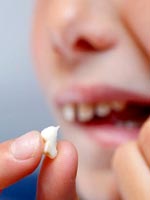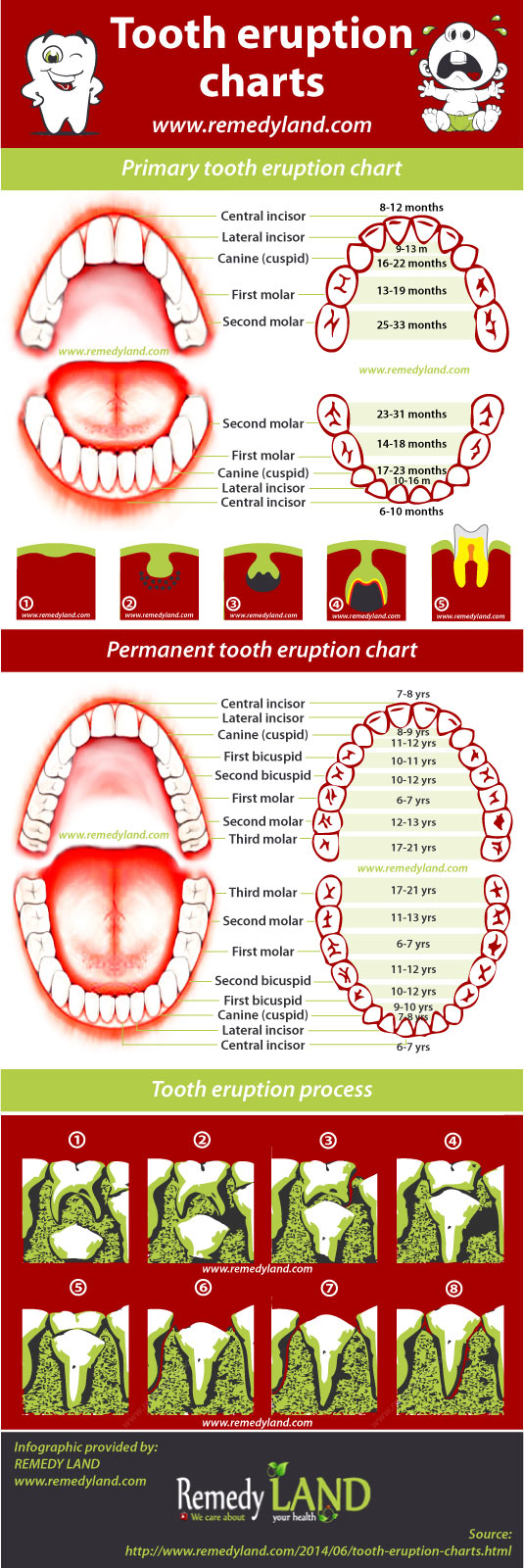From the primary tooth eruption chart you can observe that the initial teeth start to erupt at around six months of age. Typically, the two bottom central incisors are the first two teeth to break throughout the gums, after that, the top four front teeth come out. Then, gradually, another teeth start to fill in, in most cases in pairs until all twenty teeth have erupt before the kid is three years old. The full set of primary teeth is in the oral cavity from the age of three years of age.
Primary teeth eruption chart
A guideline is that for every half a year of life, about four teeth are going to erupt. Girls precede boys in baby tooth eruption. Teeth in lower jaw erupt before teeth in upper jaw. Teeth in both jaws erupt in pairs. Primary teeth are smaller and whiter in color than the secondary teeth.
After age four, the jaw and face bones of the child start to get bigger, making room between the milk teeth. This is a completely normal growing progression that creates the required space for the secondary teeth. Between the ages of six and twelve, a combination of both primary teeth and secondary teeth are in the oral cavity.
| Upper teeth | Erupt | Shed |
|---|---|---|
| Central incisor | 8 to 12 months | 6 to 7 years |
| Lateral incisor | 9 to 13 months | 7 to 8 years |
| Cuspid or canine | 16 to 22 months | 10 to 12 years |
| First molar | 13 to 19 months | 9 to 11 years |
| Second molar | 25 to 33 months | 10 to 12 years |
| Lower teeth | Erupt | Shed |
|---|---|---|
| Central incisor | 6 to 10 months | 6 to 7 years |
| Lateral incisor | 10 to 16 months | 7 to 8 years |
| Cuspid or canine | 17 to 23 months | 9 to 12 years |
| First molar | 14 to 18 months | 9 to 11 years |
| Second molar | 23 to 31 months | 10 to 12 years |
If baby teeth fallout after a few years, why is it necessary to look after milk teeth?
Healthful baby teeth are important for guiding permanent teeth, which are growing beneath them, into their proper positions. In case a primary tooth is missing, the space designed for the permanent tooth could be smaller, leading to crowding of the secondary tooth. Primary teeth provide the face its normal look and assist in the progression of clear speech patterns.
Lost or decayed teeth are forcing children to refuse foods. They provide a healthy begin to the permanent teeth, tooth decay and bacterial infection in baby teeth may cause dark spots on the secondary teeth growing underneath them. Many researchers have found that kids who had tooth decay in their primary teeth had a higher risk of having tooth decay in their adult teeth teeth compared to kids who preserved healthy primary teeth. It is very important for to have their first dental examination before all the primary teeth have erupted.
Permanent teeth eruption chart
As seen you can see in this teeth eruption chart, permanent teeth start to erupt when the child is six years old. The first permanent molars are the first to erupt. In some kids, the incisors are the first to erupt. Tooth by tooth all of the primary teeth are replaced by the thirty two permanent teeth.
The majority of the twenty eight permanent teeth are going to be in place by the age of thirteen. Occasionally wisdom teeth does not erupt. The sequence that teeth erupt can differ. You need to be more focused on symmetry of the teeth instead of the moment teeth erupt.
| Teeth | Upper teeth | Lower teeth |
|---|---|---|
| Central incisor | 7 to 8 years | 6 to 7 years |
| Lateral incisor | 8 to 9 years | 7 to 8 years |
| Cuspid or canine | 11 to 12 years | 9 to 10 years |
| First bicuspid | 10 to 11 years | 10 to 12 years |
| Second bicuspid | 10 to 12 years | 11 to 12 years |
| First molar | 6 to 7 years | 6 to 7 years |
| Second molar | 12 to 13 years | 11 to 13 years |
| Wisdom teeth | 17 to 21 years | 17 to 21 years |
You can find four different kinds of teeth:
- Incisor are the four front teeth designed for chopping and slicing food.
- Canine teeth are four pointy teeth designed for tearing food.
- Premolars are eight teeth adjacent to your canine teeth. They are bigger and wider and useful for crushing and milling food.
- Molars are the eight most powerful teeth and they are working with your tongue to help you digest food easily.




